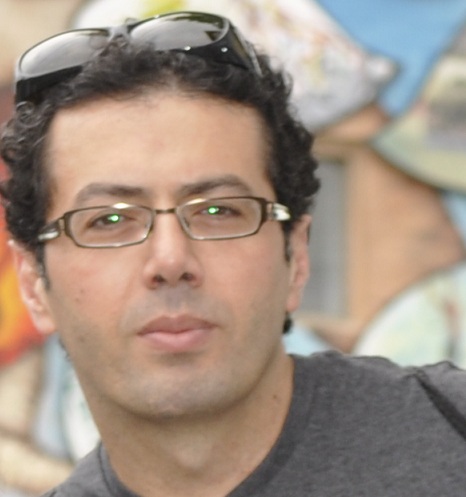www.aljazeerah.info
Opinion Editorials, September 2019
Archives
Mission & Name
Conflict Terminology
Editorials
Gaza Holocaust
Gulf War
Isdood
Islam
News
News Photos
Opinion Editorials
US Foreign Policy (Dr. El-Najjar's Articles)
www.aljazeerah.info
Humanity Denied: What Is Missing from the Story of Ilhan Omar and Rashida Tlaib By Ramzy Baroud Al-Jazeerah, CCUN, September 1, 2019 |
 |
 |
|
| US Congresswomen Ilhan Omar and Rashida Tlaib |
Israel’s decision to bar two United States Democratic Representatives, Ilhan Omar and Rashida Tlaib, from entering Israel and visiting Palestine has further exposed the belligerent, racist nature of the Israeli government.
But our understanding of the Israeli decision and the massive controversy and discussion it generated should not stop there. Palestinians, who have been at the receiving end of racist Israeli laws, will continue to endure separation, isolation and travel restrictions long after the two Congresswomen’s story dies down.
A news feature published by the British Guardian newspaper last June told the story of Palestinian children from Gaza who die alone in Makassed Hospital in Jerusalem.
Ever since Israel imposed near-complete isolation on the Gaza Strip in 2007, thousands of Palestinian patients requiring urgent medical care which is available in Palestinian East Jerusalem or elsewhere in the West Bank faced options, all of them painful. As a result, many died at home, while others waited for months, if not years, to be granted permission to leave the besieged Strip.
The Guardian reported on 56 Gaza babies who were brought to the Makassed Hospital, alas without any family accompanying them. Six of these babies died alone.
The Israeli rights group, Gisha, puts this sad reality in numbers. When the Beit Hanoun (Erez) Crossing between Gaza and Israel is not completely shut down, only 100 Gazans are allowed to cross into Israel (mostly on their way to the West Bank) per day. Before the breakout of the Second Palestinian Intifada, the Uprising of 2000, “the monthly average number of entries to Israel from Gaza by Palestinians was more than half a million.”
One can only imagine the impact of such a massive reduction on the Palestinian community in the Strip in terms of work, health, education and social life.
This goes well beyond Gaza. Indeed, if there is one consistent policy that has governed Israel’s relationship with Palestinians since the establishment of Israel on the ruins of Palestinian towns and villages in 1948, it is that of separation, siege and physical restrictions.
While the establishment of Israel resulted in the massive influx of Palestinian refugees who are now numbered in the millions and are still denied the right even to visit their own homeland, those who remained in Palestine were detained in small, cut off spaces, governed by an inhumane matrix of control that only grows more sophisticated with time.
Immediately after the establishment of Israel, Palestinian Christian and Muslim communities that were not ethnically cleansed by Zionist militias during the war endured years of isolation under the so-called Defense (Emergency) Regulations. The movement of Palestinians in these areas were governed by military law and the permit system.
Following the 1967 occupation of the remaining 22 percent of historic Palestine, the emergency law was also applied to East Jerusalem, the West Bank and Gaza. In fact, in the period between 1967 and 1972, all of the occupied territories were declared a “closed military area” by the Israeli army.
In the period between 1972 and 1991, Palestinian laborers were allowed entry to Israeli only to serve as Israel’s cheap workforce. Hundreds of thousands of impoverished, desperate, though often well-educated Palestinians, faced the inevitable option of enduring humiliating work conditions in Israel in order to sustain their families. But even that route was closed following the First Intifada of 1987 particularly after the Iraq war in 1991. Total closure was once more imposed on all Palestinians throughout the country.
The Oslo Agreement, which was put into effect in 1994, formalized the military permit system. Oslo also divided the West Bank into three zones, A, B, C and with the latter two (comprising nearly 83 percent of the total size of the West Bank) falling largely under total Israeli control. This ushered in yet another horrific reality as it isolated Palestinians within the West Bank from one another.
Occupied East Jerusalem also fell into the same matrix of Israeli control. After 1967, Palestinian Jerusalemites were classified into those living in area J1 – Palestinians with blue cards living in areas annexed by Israel after the war and incorporated into the boundaries of the Israeli Jerusalem municipality; and J2- Palestinians residing outside the municipality area. Regardless, both communities were denied “fundamental residency rights to adequate housing and freedom of movement and their rights to health, work, (and) education,” wrote Fadwa Allabadi and Tareq Hardan in the Institute for Palestinian Studies.
The so-called ‘Separation Wall’, which Israel began building in June 2002, did not separate between Palestinians and Israel, for that has already been realized through numerous laws and restrictions that are as old as the Israeli state itself. Instead, the wall created yet more restrictions for Palestinians, who are now left isolated in Apartheid South Africa-style ‘Bantustans’. With hundreds of permanent and “flying” military checkpoints dotting the West Bank, Israel’s separation strategy was transformed from isolating all Palestinians at once, into individualized confinement that is aimed at destroying any sense of Palestinian socio-economic cohesion and continuity.
Moreover, the Israeli military “installed iron gates at the entrances to the vast majority of West Bank villages, allowing it to isolate them within minutes and with minimal personnel,” according to the Israeli rights group, B’Tselem research.
It does not end here, of course. In March 2017, the Israeli parliament (Knesset) approved an amendment to the law that would deny entry to foreign nationals who “knowingly issued a public call to boycott the state of Israel.” The “Boycott law” was rooted in a 2011 bill and an Israeli Supreme Court decision (upholding the legal argument in the bill) in 2015.
According to the Israeli website, Globes, in 2018, almost 19,000 visitors to Israel were turned away at the country’s various entry points, compared to only 1,870 in 2011. Ilhan Omar and Rashida Tlaib will now be added to that dismal statistic.
Every Palestinian, anywhere, is subjected to these restrictions. While some are denied the right to visit their families, others are dying in isolation in besieged areas, in “closed military zones”, while separated from one another by massive walls and numerous military checkpoints.
This is the story of Palestinian isolation by Israel that we must not allow to die out, long after the news cycle covering the two Congresswomen’s story move on beyond Omar, Tlaib and Israeli transgressions.
– Ramzy Baroud is a journalist, author and editor of The Palestine Chronicle. His last book is ‘The Last Earth: A Palestinian Story’ (Pluto Press, London) and his forthcoming book is ‘These Chains Will Be Broken: Palestinian Stories of Struggle and Defiance in Israeli Prisons’ (Clarity Press, Atlanta). Baroud has a Ph.D. in Palestine Studies from the University of Exeter. His website is www.ramzybaroud.net
***
Share the link of this article with your facebook friends
|
|
|
|
||
|
||||||


